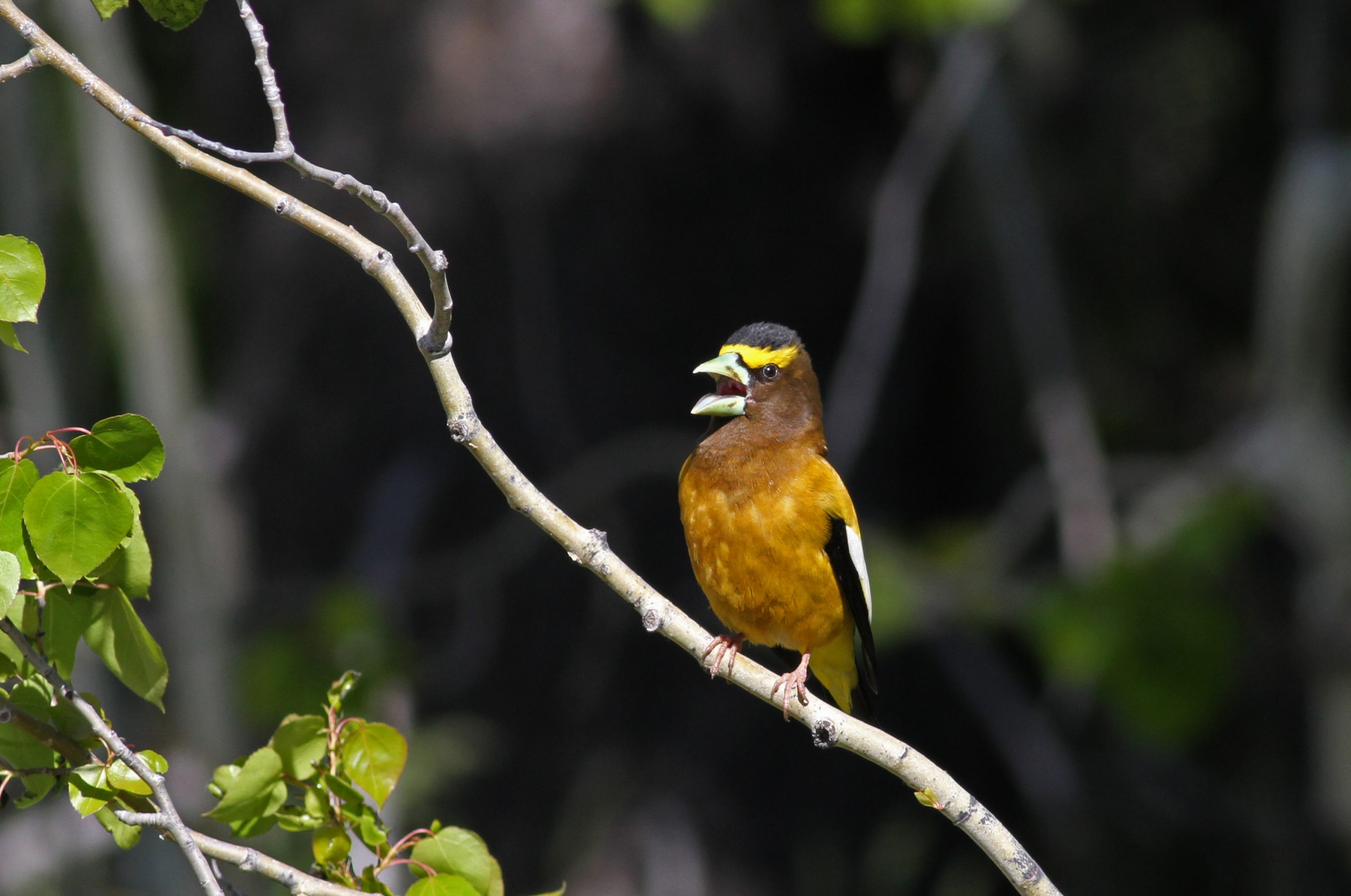Evening Grosbeak Research in Oregon:
By Will Kirsch
For decades, one of the great natural spectacles at Oregon State University (OSU) has been the massive flocks of Evening Grosbeaks that push through campus each April and May. During this timeframe, thousands of these bold, beautiful finches cling to the tops of the many elm trees around, and noisily feed on the protein rich seeds they contain. They call and forage almost continuously, fattening up before heading to their breeding grounds in the nearby Coast Range or further throughout the Pacific Northwest. All the raucous created by the Grosbeaks creates quite the show for the numerous bird enthusiasts like me at OSU, as well as the few passerby scrambling from class to class who happen to pull out their AirPods and look up from their phones.
Elm seeds discarded by foraging Evening Grosbeaks along Campus Way. Photo by Doug Robinson.
As with essentially any great natural phenomenon, the magic of Evening Grosbeak migration at OSU is far from what it once was. Estimates from the 1970s gave numbers of at least 150,000-250,000 birds passing through, with local newspapers even reporting that students walking between classroom buildings “carried umbrellas, even on sunny days, to shield themselves from grosbeak droppings” (Robinson et al. 2022). Today, the Evening Grosbeak is among the fastest declining landbirds in North America (FiRN 2022).
To better understand the reasons behind these declines, a variety of projects are currently being conducted within the Robinson Lab at OSU. One project currently underway has been to survey Evening Grosbeaks on Campus.
This year, due to late spring rains and colder than expected temperatures, Grosbeak movements were delayed this year and the first big foraging flocks did not arrive until April 27th. However, the ensuing weeks proved to be a very fruitful year for these birds compared to past years, and we found numbers peaking around 1,290 birds on May 9th.
In addition to estimating numbers of Evening Grosbeaks passing through Campus, the Robinson Lab also aims to characterize the vocabulary of Evening Grosbeaks, and many recordings were obtained and will be analyzed before we seek to publish our findings later this year.
Recording Evening Grosbeaks near Strand Agricultural Hall at the beginning of a spring survey. Photo by Doug Robinson.
Throughout their range, Evening Grosbeak make up five distinct call types or groups, similar to the different types of crossbills (Sewall et al. 2004), and type 1 Evening Grosbeaks essentially comprise the entirety of birds found throughout OSU. These birds are distinguished from other call types by the single descending note given, which oddly enough has been described by one 19th century observer as “strikingly like the call of a lost chicken” (Contreras et al. 2022, p. 35).
Spectrogram of Evening Grosbeaks flight calls at OSU. The bolded descending call note is that of a type 1 bird. Photo by Will Kirsch.
Likewise, as an extension of this work on Campus, the Robinson Lab will also be conducting Evening Grosbeak research in southern Oregon. Here, we will be surveying birds, at a variety of sites within the southern Cascade Mountains and work with UC Davis collaborator Tom Hahn, who currently has an existing network of automatic recording units (ARU) (provided by FiRN and the Cornell Lab of Ornithology) and throughout this region and northern California.
These surveys as well as the ARU network will allow us to help detect the overlap zones between type 1 and 2 Evening Grosbeaks, and provide us with the necessary information to better answer bigger ecological questions such as assortative mating within Evening Grosbeak types.
Ultimately, we hope this research will better provide us the tools and insights necessary to better learn how to protect this species, with the end goal that maybe one day students at OSU will once again walk around with umbrellas trying to not get pooped on by these charismatic, inspiring, and beautiful birds.
And to that point, we have started a FiRN North America Evening Grosbeak Foraging Project in iNaturalist: www.inaturalist.org/projects/evening-grosbeak-foraging
And stay tuned for the Winter Finch Forecast on September 24th.
Cover Photo Jay McGowan
References
Contreras, A., Thompson, V. E., Clements, N. M., Adamus, P. R., McQueen, L. B., & Bullick, J. (2022). A History of Oregon Ornithology: Territorial days to the rise of birding. Oregon State University Press.
Finch Research Network. International road to recovery Evening Grosbeak project. (2022, November 20). Retrieved February 11, 2023, from https://finchnetwork.org/projects/the-evening-grosbeak-project
Robinson, W. D., Greer, J., Masseloux, J., Hallman, T. A., & Curtis, J. R. (2022). Dramatic declines of evening grosbeak numbers at a spring migration stop-over site. Diversity, 14(6), 496. https://doi.org/10.3390/d14060496
Sewall, K., Kelsey, R., & Hahn, T. P. (2004). Discrete variants of evening grosbeak flight calls. The Condor, 106(1), 161–165. https://doi.org/10.1093/condor/106.1.161
For other Finch Research Network iNaturalist Projects see here, Become a Finch Forecaster:
https://www.inaturalist.org/projects/become-a-finch-forecaster-finch-forecast-food-assessment
North American Red Crossbill Foraging Project:
https://www.inaturalist.org/projects/red-crossbill-foraging-in-north-america
FiRN is a nonprofit, and was been granted 501c3 status in 2020. We are a co-lead on the Evening Grosbeak Road to Recovery Project, and have funded upwards of $10,000 to go towards research, conservation and education for finch projects in the last year plus. FiRN is committed to researching and protecting these birds and other threatened finch species like the Evening Grosbeak, Rosy-finches, and Hawaii’s finches the honeycreepers, and if you have been enjoying all the blogs and identifying of Evening Grosbeak and Red Crossbill call types (upwards of 15,000 recordings listened to), redpoll subspecies and green morph Pine Siskins FiRN has helped with over the years, please think about supporting our efforts and making a small donation at the donate link below.

